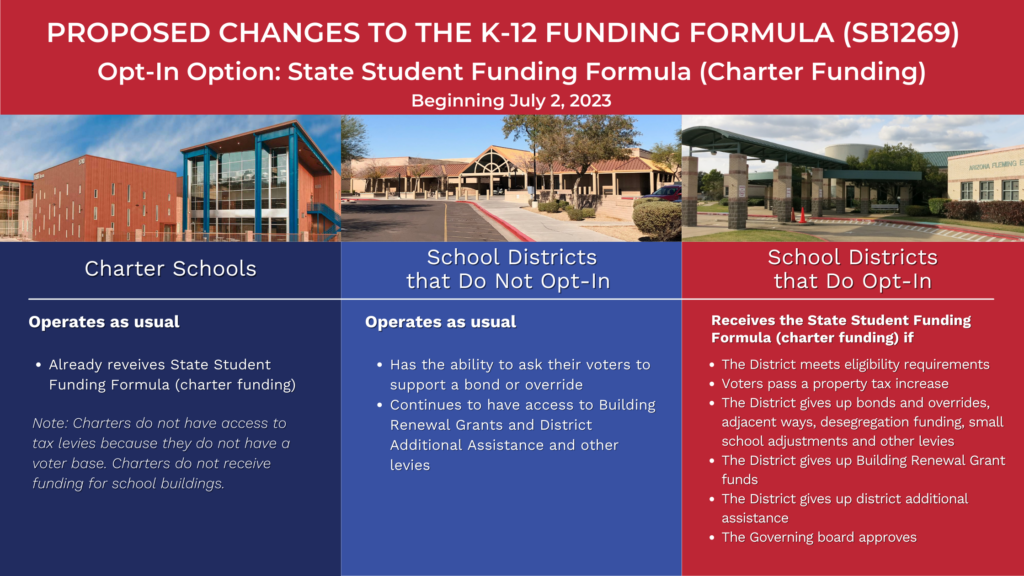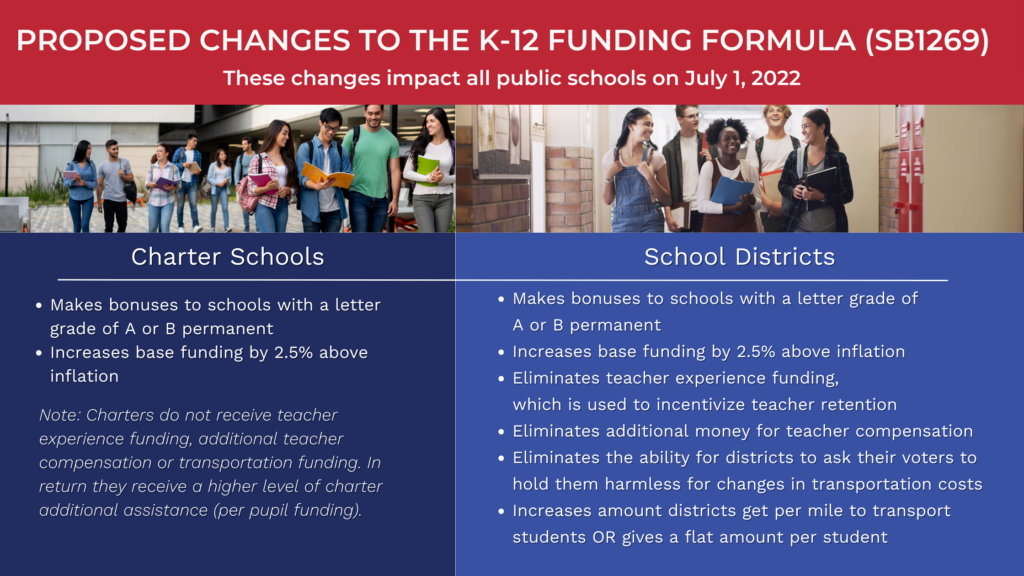
What’s Important to Include in a School Funding Proposal & the Impact of SB1269
The legislature is considering proposals that would change the school funding formula and add new funding to schools if a grand bargain is made. As policymakers debate these proposals, we believe it is important to zoom out to look at the bigger picture of school funding needs in Arizona.
We believe any changes to the K-12 formula and any major increases in school funding should address a long-term solution for education that:
- Includes early education, K-12 and postsecondary education: Funding conversations should include a comprehensive solution for P-20 education, including things like increasing quality PreK for 3-and 4-year olds, fully funding Kindergarten and providing scholarships to low-income students to earn a degree or credential.
- Supports Low-Income Students: More funding should be allocated to support the needs of low-income students, who require more supports to be successful in school.
- Provides Long-Term Solutions: A funding solution should address the long-term fix for the Aggregate Expenditure Limit for K-12 and community colleges. These are the spending caps voters passed in 1980 that are limiting the ability for schools and community colleges to spend the money they already have. Additionally, Prop 123 will expire in FY25, which will lead to a drop in K-12 funding of $300M+ a year.
- Recruits and Retains Educators: Any investments in education should prioritize educator recruitment and retention, with a focus on early education and K-12 education.
- Supports Students with Disabilities: Significant state funding should also be allocated to support students with disabilities.
As funding and changes to the school funding formula are proposed, this is the lens we’ll be using to advocate and weigh in on proposals.
Proposed Changes to the School Funding Formula (SB1269)
There’s a current proposal that the legislature is considering (SB1269) that would significantly change the K-12 funding formula. The school funding formula is a bit of a wonky thing, but in the end, if the bill were to move forward, it would make cuts to funds used for teacher retention and pay, cut school transportation funding, and would make permanent the bonuses that schools receive for earning an A or B letter grade, which gives funding to the schools who need it the least. (School letter grades are dependent on state test scores which are correlated with student income levels. Typically schools with higher income levels perform better on the state test and have better school letter grades.) The bill also proposes to add a small increase to overall funding (2.5%) and includes some funding to address the cuts in transportation, however, the estimates won’t make up for the cuts proposed for many schools.
Here’s a breakdown of the proposed changes and how it would impact all public schools, which includes school districts and charter schools:
These proposed changes affect each school district and charter school differently, with some seeing a net increase in funding and others seeing a cut in funding. One analysis by the Education Finance Reform Group estimates that 80 school districts could benefit, while 140 would lose funding under this proposal. The majority of charter schools would see an increase with the proposal.
What Else Does this Bill Include?
The other major change in the bill would allow school districts to choose to be funded as if they were a charter school. This part of the bill is optional, meaning that school districts could opt in if they want to participate.
If they want to opt in, schools must meet eligibility requirements, ask their voters for approval, and ask voters to pass a property tax increase in order for the district to participate, which could be a challenge for some school districts who struggle to pass bonds or overrides.
If all of these conditions are met, the school district would receive a higher amount of per-pupil funding from the state, but they would have to give up their opportunity to ask their voter base for additional support through things like bonds and overrides (which is how many schools raise money to hire staff, offer full-day Kindergarten, offer music and arts programs, buy new curriculum and build school buildings – among other uses). Additionally, schools would give up funding that the state provides to school districts to fix up their existing school buildings.
The Joint Legislative Budget Committee estimates that 26 districts (out of more than 220+) would be eligible to opt in initially and would benefit from this proposal.

Concerns with the Proposal
First, the bill was introduced at the last minute during legislative session, which means that legislators and the public did not have time to review and debate the proposal. It was also introduced with little stakeholder engagement, meaning that schools and those groups representing schools were not included in the conversation to develop the proposal and many didn’t have an opportunity to provide feedback before or during the committee hearing where testimony was limited.
Most concerning to us is the proposed cut of $124M in funding that supports teacher pay and keeps experienced teachers in the classroom. These cuts are not made up by the increase to the base of overall funding for many districts, many of which are rural schools. Arizona is facing a significant teacher shortage. We should be doing everything we can to retain teachers, not cut funding that helps us keep them in the classroom.
Further, the proposal changes transportation funding by saying that districts can no longer ask their voters to cover some of the transportation costs that hold them harmless for changes in transportation levels from previous years. This means a cut in transportation funding for many districts. In return, the proposal offers a tradeoff to either increase the amount of funding schools receive per mile or to fund schools at a flat amount per student. However, this proposal doesn’t makeup enough to cover the real costs of student transportation for the majority of school districts.
While the proposal adds more funding to schools (a 2.5% increase of $170 million), the amount decreases over time and drops to $100 million in its fifth year. This increase doesn’t make up for these cuts proposed and does not get us to the significant investment that’s needed to support education.
Also concerning, is that it makes the bonuses that A and B schools receive permanent, which is giving funding to the schools who likely need it the least. This change is important because school letter grades are highly dependent on how well a school does on the statewide assessment, which is highly correlated with the income level of the school. Schools with a higher level of income generally have higher levels of achievement and better school letter grades. By making this permanent, it is adding a “wealth weight” to the school funding formula. If we are going to make this permanent, why not also fund an opportunity weight that would give schools with high proportions of low-income students funding to support the additional needs these students have?
Further, the proposal to allow school districts to opt in to receive charter school funding (State Additional Assistance) may make sense for a few districts (just 26 will be eligible and will gain revenue if they opt in). However, opting in requires a steep lift for districts that have to ask their voters to raise property taxes. For those districts who have struggled to pass a bond or override in the past, passing this election will likely be a challenge. Additionally, the district has to give up any future bonds, overrides or other tax levies and funds from the state to maintain school buildings.
In summary, this bill misses the mark. It does not address the long-term solution that’s needed for P-20 education. The changes to the funding formula create more losers than winners, and the option to opt in to receive charter funding requires too large of a tradeoff and has a set of requirements that will be difficult for districts to meet.
Take Action
Your voice is helpful in opposing the bill in its current form or if it comes back as a part of the budget conversation.
Join us in sharing your thoughts with your policymakers about this school funding overhaul.
Resources
JLBC Fiscal Note (with estimated impact by school district and charter school)
Arizona Republic – Arizona Legislature Panel OKs Rushed K-12 Funding Overhaul

